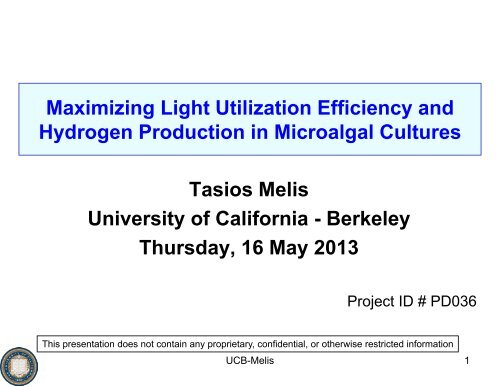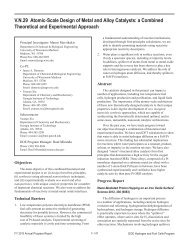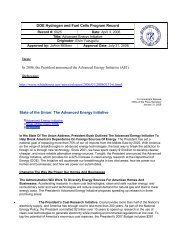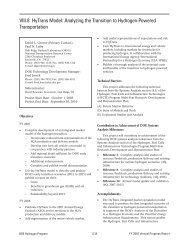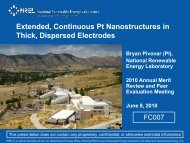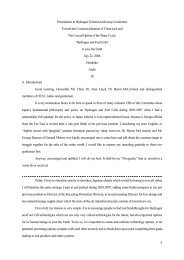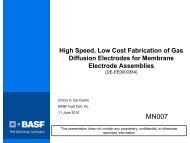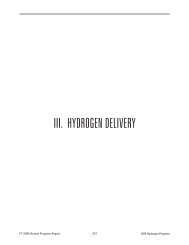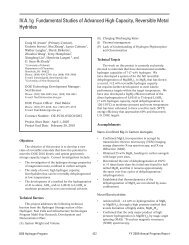Maximizing Light Utilization Efficiency and Hydrogen Production in ...
Maximizing Light Utilization Efficiency and Hydrogen Production in ...
Maximizing Light Utilization Efficiency and Hydrogen Production in ...
You also want an ePaper? Increase the reach of your titles
YUMPU automatically turns print PDFs into web optimized ePapers that Google loves.
<strong>Maximiz<strong>in</strong>g</strong> <strong>Light</strong> <strong>Utilization</strong> <strong>Efficiency</strong> <strong>and</strong><br />
<strong>Hydrogen</strong> <strong>Production</strong> <strong>in</strong> Microalgal Cultures<br />
Tasios Melis<br />
University of California - Berkeley<br />
Thursday, 16 May 2013<br />
Project ID # PD036<br />
This presentation does not conta<strong>in</strong> any proprietary, confidential, or otherwise restricted <strong>in</strong>formation<br />
UCB-Melis<br />
1
Overview<br />
Timel<strong>in</strong>e<br />
• Start: 01-Dec-2004<br />
• End: 31-Jan-2014<br />
• Completion: 95%<br />
Budget<br />
Barriers<br />
• Low <strong>Light</strong> <strong>Utilization</strong> <strong>Efficiency</strong><br />
<strong>in</strong> Photobiological <strong>Hydrogen</strong><br />
<strong>Production</strong> due to a Large<br />
Photosystem Chlorophyll<br />
Antenna Size (Barrier AN).<br />
• Total Project Fund<strong>in</strong>g<br />
- DOE: $1.74M<br />
- UCB: $ 675K<br />
- Swedish Res Council: $55.2K (FY11)<br />
• Fund<strong>in</strong>g received <strong>in</strong> FY12: $150K<br />
• Planned fund<strong>in</strong>g for FY13: $150K<br />
UCB-Melis<br />
Partners<br />
• NREL<br />
• Swedish Research<br />
Council<br />
2
Relevance<br />
The TLA concept<br />
(TLA = Truncated <strong>Light</strong>-harvest<strong>in</strong>g Antenna):<br />
M<strong>in</strong>imize the light-harvest<strong>in</strong>g antenna size of the<br />
photosystems to prevent the early light-saturation of<br />
photosynthesis <strong>and</strong> the associated wasteful dissipation of<br />
absorbed sunlight.<br />
Relevance<br />
Improve, the sunlight-utilization efficiency of<br />
photosynthesis <strong>in</strong> microalgae by up to 300%, which will improve<br />
H 2 or fuels production <strong>in</strong> microalgae <strong>and</strong> cyanobacteria by about<br />
the same percentage.<br />
The work l<strong>in</strong>ks with effort both at NREL <strong>and</strong> at the J. Craig<br />
Venter Institute, where H 2 -production technologies <strong>in</strong> microalgae<br />
<strong>and</strong> cyanobacteria are be<strong>in</strong>g developed.<br />
UCB-Melis<br />
3
Relevance<br />
Example:<br />
Fully Pigmented<br />
H 2<br />
The green algae<br />
Chlamydomonas re<strong>in</strong>hardtii<br />
Bright<br />
Sunlight<br />
Heat dissipation<br />
Fully pigmented cells over-absorb <strong>and</strong> wastefully dissipate bright sunlight.<br />
UCB-Melis<br />
4
Relevance<br />
Example: Truncated<br />
Chl Antenna Size<br />
Bright<br />
Sunlight<br />
H 2<br />
H 2 H2 H2<br />
Heat dissipation<br />
Truncated Chl antenna cells permit greater transmittance of light <strong>and</strong><br />
overall better solar utilization by the culture.<br />
UCB-Melis<br />
5
Objectives <strong>and</strong> Approach<br />
Chlorophyll a <strong>and</strong> b antenna size <strong>in</strong> microalgae<br />
Large Chl<br />
Antenna Size<br />
(600 Chl a <strong>and</strong> b)<br />
Wild type<br />
Genetic<br />
determ<strong>in</strong>ants<br />
Truncated Chl<br />
Antenna Size<br />
(130 Chl a)<br />
TLA<br />
Identify genes <strong>and</strong> molecular mechanisms to enable a<br />
truncated antenna size <strong>in</strong> microalgae <strong>and</strong> cyanobacteria.<br />
UCB-Melis<br />
6
Objectives <strong>and</strong> Approach<br />
Objectives:<br />
Identify genes <strong>and</strong> associated molecular mechanisms that confer a<br />
Truncated <strong>Light</strong>-harvest<strong>in</strong>g Antenna (TLA property) <strong>in</strong> the tla3<br />
stra<strong>in</strong>s of Chlamydomonas re<strong>in</strong>hardtii.<br />
Develop protocols for the targeted truncation of the light-harvest<strong>in</strong>g<br />
antenna size <strong>in</strong> cyanobacteria.<br />
Approach:<br />
(a) Clon<strong>in</strong>g of the genes responsible for the TLA3 phenotype <strong>in</strong><br />
Chlamydomonas re<strong>in</strong>hardtii. (b) Identification of genes to be<br />
<strong>in</strong>terrupted or deleted <strong>in</strong> cyanobacteria. (c) Functional analysis of<br />
the transformants (Berkeley expertise).<br />
UCB-Melis<br />
7
PART 1<br />
Green Microalgae<br />
UCB-Melis 8
Microalgae Accomplishments <strong>and</strong> Progress<br />
Sunlight <strong>Utilization</strong> <strong>Efficiency</strong>, % of Incident Solar Energy<br />
(maximum possible = 30%)<br />
2000 2003 2005 2007 2008 2010 2011 2012 2015<br />
Targets<br />
(<strong>Light</strong><br />
utilization<br />
efficiency)<br />
3% 10% 15% 20%<br />
Tla stra<strong>in</strong><br />
with the<br />
highest<br />
efficiency<br />
identified<br />
3%<br />
(WT)<br />
10%<br />
TLA1<br />
15%<br />
TLA2<br />
25%<br />
TLA3<br />
Gene clon<strong>in</strong>g<br />
from the TLA<br />
stra<strong>in</strong>s<br />
TLA1:<br />
Mov34<br />
MPN<br />
TLA2:<br />
FTSY<br />
TLA3:<br />
SRP43<br />
9
Microalgae Accomplishments <strong>and</strong> Progress<br />
Mechanism of TLA2 <strong>and</strong> TLA3 Function <strong>in</strong> LHC-prote<strong>in</strong> assembly<br />
UCB-Melis 10
PART 2<br />
Cyanobacteria<br />
UCB-Melis 11
Cyanobacterial Approach<br />
Unit photosynthetic apparatus <strong>and</strong> cyanobacterial antenna organization<br />
PBS<br />
PC<br />
PC<br />
AP<br />
AP<br />
cytosol<br />
95<br />
Chl<br />
Fx<br />
P700<br />
95<br />
Chl<br />
Fx<br />
P700<br />
Qa<br />
P680<br />
Qa<br />
P680<br />
Fx<br />
P700<br />
95<br />
Chl<br />
Fx<br />
P700<br />
95<br />
Chl<br />
Thylakoid<br />
membrane<br />
95 Chl<br />
for each PSI<br />
35 Chl<br />
for each PSII<br />
lumen<br />
Photosystem stoichiometry <strong>and</strong> phycobilisome-chlorophyll antenna organization <strong>in</strong> the<br />
thylakoid of cyanobacteria. Cyanobacteria may possess up to 850 phycocyan<strong>in</strong> (PC),<br />
allophycocyan<strong>in</strong> (AP), <strong>and</strong> chlorophyll (Chl) molecules per unit photosynthetic apparatus.<br />
Phycobilisome (PBS) schematic adapted from Glazer <strong>and</strong> Melis 1987.<br />
UCB-Melis 12
Cyanobacterial Approach<br />
Unit photosynthetic apparatus <strong>and</strong> cyanobacterial TLA organization<br />
The model shows the anticipated antenna size <strong>in</strong> TLA cyanobactaria<br />
AP-core<br />
AP<br />
AP<br />
cytosol<br />
95<br />
Chl<br />
Fx<br />
P700<br />
95<br />
Chl<br />
Fx<br />
P700<br />
Qa<br />
P680<br />
Qa<br />
P680<br />
Fx<br />
P700<br />
95<br />
Chl<br />
Fx<br />
P700<br />
95<br />
Chl<br />
Thylakoid<br />
membrane<br />
95 Chl<br />
for each PSI<br />
35 Chl<br />
for each PSII<br />
lumen<br />
Go/No-Go Decision: Present evidence at the molecular <strong>and</strong> biochemical levels to<br />
demonstrate proof-of concept <strong>and</strong> capability of gene replacement <strong>in</strong> cyanobacteria, as the<br />
method of choice for the generation of TLA mutants <strong>in</strong> these photosynthetic microorganisms.<br />
UCB-Melis 13
Cyanobacterial Approach<br />
Replacement of the phycocyan<strong>in</strong>-encod<strong>in</strong>g operon (Go/No-Go Decision)<br />
Wild type Synechocystis genomic DNA<br />
F1<br />
!"# $"#<br />
cpcB cpcA cpcC cpcC cpcD<br />
R5<br />
F3<br />
F1<br />
Kanamyc<strong>in</strong><br />
resistance<br />
!"# $"#<br />
R5<br />
R3<br />
F3<br />
!cpc replacement<br />
R3<br />
WT<br />
!cpc<br />
Expected PCR product size:<br />
WT [bp] !cpc [bp]<br />
F3R3 4683 2126<br />
F1R5 4973 2416<br />
kb<br />
5<br />
4<br />
3<br />
2<br />
F3 F1 F3 F1<br />
R3 R5 R3 R5
Cyanobacterial Approach<br />
Molecular <strong>and</strong> Physiological Evidence of Transformation (Go/No-Go Decision)<br />
Wild type Synechocystis<br />
Blue-green phenotype<br />
due to PC <strong>and</strong> Chl pigments<br />
Δcpc transformants<br />
Green phenotype<br />
<strong>in</strong>dicat<strong>in</strong>g loss of PC
Cyanobacterial Approach<br />
Biochemical Evidence of Transformation (Go/No-Go Decision)<br />
PC<br />
APC Chl<br />
Absorbance<br />
WT<br />
Δcpc<br />
Synechocystis<br />
Wavelength, nm
Accomplishments <strong>and</strong> Progress<br />
Evidence is presented at the genetic <strong>and</strong> molecular levels to<br />
demonstrate successful double homologous recomb<strong>in</strong>ation for<br />
replacement of the cpc DNA operon <strong>in</strong> cyanobacteria.<br />
Further evidence is presented at the biochemical level to show the<br />
ensu<strong>in</strong>g absence of phycocyan<strong>in</strong> light-harvest<strong>in</strong>g pigments from<br />
cyanobacteria (∆cpc stra<strong>in</strong>s), seen by the green coloration of the<br />
latter, as opposed to the blue-green coloration of the wild type <strong>and</strong> by<br />
the absence of phycocyan<strong>in</strong> from the absorbance spectra of the ∆cpc<br />
stra<strong>in</strong>s.<br />
UCB-Melis<br />
17
Accomplishments <strong>and</strong> Progress<br />
Peer reviewed publications:<br />
Mitra M, Dewez D, García-Cerdán JG, Melis A (2012) Polyclonal<br />
antibodies aga<strong>in</strong>st the TLA1 prote<strong>in</strong> also recognize with high<br />
specificity the D2 reaction center prote<strong>in</strong> of PSII <strong>in</strong> the green<br />
alga Chlamydomonas re<strong>in</strong>hardtii. Photosynth Res 112:39-47<br />
Kirst H, Garcia-Cerdan JG, Zurbriggen A, Ruehle T, Melis A (2012)<br />
Truncated photosystem chlorophyll antenna size <strong>in</strong> the green<br />
microalga Chlamydomonas re<strong>in</strong>hardtii upon deletion of the<br />
TLA3-CpSRP43 gene. Plant Physiol. 160(4):2251-2260<br />
Mitra M, Kirst H, Dewez D, Melis A (2012) Modulation of the lightharvest<strong>in</strong>g<br />
chlorophyll antenna size <strong>in</strong> Chlamydomonas<br />
re<strong>in</strong>hardtii by TLA1 gene over-expression <strong>and</strong> RNA<br />
<strong>in</strong>terference. Phil. Trans. R. Soc. B 367:3430-3443<br />
UCB-Melis<br />
18
Accomplishments <strong>and</strong> Progress<br />
• Successfully completed the TLA3 project,<br />
deposited stra<strong>in</strong>s <strong>in</strong> the Chlamydomonas library<br />
• Successfully applied the TLA concept to<br />
cyanobacteria.<br />
• Potential of enhanc<strong>in</strong>g photosynthetic efficiencies<br />
<strong>and</strong> hydrogen production of cyanobacteria under<br />
mass culture conditions.<br />
UCB-Melis<br />
19
Collaborations, Applications, <strong>and</strong> Impact of<br />
the R&D<br />
The TLA concept is applied at:<br />
NREL <strong>and</strong> by the Brisbane (Australia)-Bielefeld (Germany)<br />
groups <strong>in</strong> Chlamydomonas for H 2 production <strong>and</strong> by the U-<br />
Wagen<strong>in</strong>gen (The Netherl<strong>and</strong>s) for biomass production, <strong>and</strong> by<br />
two companies <strong>in</strong> the private sector for commercial production<br />
of polyunsaturated fatty acids (PUFAs) <strong>in</strong> Nannochloropsis.<br />
TLA stra<strong>in</strong>s were requested from the Chlamydomonas library<br />
<strong>and</strong> acquired by universities (x29), <strong>in</strong>dustry (x14), government<br />
labs (x4), research <strong>in</strong>stitutions (5), <strong>and</strong> high schools (x6).<br />
(A total of 58 stra<strong>in</strong>s were shipped s<strong>in</strong>ce 2010, most of them <strong>in</strong><br />
2012.)<br />
Collaboration was offered <strong>in</strong> the form of advis<strong>in</strong>g some of the<br />
above groups <strong>in</strong> the use of the TLA stra<strong>in</strong>s.<br />
UCB-Melis<br />
20
Proposed Future Work<br />
Compete the analysis of the TLA cyanobacteria, <strong>in</strong>clud<strong>in</strong>g:<br />
(i) Assessment of stability <strong>and</strong> fitness of the Δcpc transformants;<br />
(i) Organization of the photosynthetic apparatus (measurement of PS<br />
stoichiometry <strong>and</strong> functional antenna size <strong>in</strong> the Δcpc transformants);<br />
(ii) <strong>Efficiency</strong> <strong>and</strong> productivity of photosynthesis measurements from the<br />
light-saturation curve); <strong>and</strong><br />
(iii) Measurements of Δcpc productivity under mass culture conditions.<br />
(Currently <strong>in</strong> progress.)<br />
Advance exploration of the “extended photosynthetically active<br />
radiation” (ePAR) concept.<br />
(Proprietary molecular genetic design not disclosed. Please see next slide<br />
for a concept explanation, to be further discussed dur<strong>in</strong>g the presentation.)<br />
UCB-Melis<br />
21
Proposed Future Work<br />
Extended photosynthetically active radiation” (ePAR) concept<br />
Quantum irradiance,!<br />
x10 12 quanta m -1 s -1 nm -1<br />
5<br />
4<br />
3<br />
2<br />
1<br />
VISIBLE!<br />
Green Algae!<br />
UCB-Melis<br />
NEAR!<br />
INFRARED!<br />
Photo Bacteria<br />
45% of sunlight 20% of sunlight<br />
0<br />
300 500 700 900<br />
Wavelength, nm<br />
22
Technical Backup Slides<br />
UCB-Melis 23
Additional Exploratory PCR Analyses<br />
Undertaken for<br />
Wild type <strong>and</strong> Δcpc transformants
WT gDNA<br />
5’ cpcB cpcA cpcC cpcC cpcD 3’<br />
F1<br />
F2 F3<br />
R1 R2<br />
5’ 3’<br />
Kan<br />
Δcpc transformant gDNA<br />
Expected product size<br />
Primer set Length [bp]<br />
F1R1 935<br />
F2R1 819<br />
F3R1 769<br />
F1R2 1003<br />
F2R2 887<br />
F3R2 837<br />
1000<br />
bp<br />
850<br />
F1<br />
R1<br />
F2<br />
R1<br />
F3 F1<br />
R1 R2<br />
F2 F3<br />
R2 R3
WT gDNA<br />
5’ cpcB cpcA cpcC cpcC cpcD 3’<br />
bp<br />
1000<br />
850<br />
Δcpc transformant gDNA<br />
F4<br />
R3<br />
F4<br />
R4<br />
F4 F5<br />
R5 R3<br />
F5<br />
F4<br />
5’ 3’<br />
Kan<br />
F5 F5<br />
R4 R5<br />
positive control<br />
R3<br />
R4<br />
R5<br />
Expected product size<br />
Primer set Length [bp]<br />
F4R3 825<br />
F4R4 894<br />
F4R5 949<br />
F5R3 1008<br />
F5R4 1077<br />
F5R5 1132
Chl Antenna Size vs <strong>Light</strong> <strong>Utilization</strong> <strong>Efficiency</strong><br />
<strong>Utilization</strong> <strong>Efficiency</strong> of Absorbed <strong>Light</strong> Energy<br />
• Wild type antenna size = 470 Chl molecules (100%)<br />
(PSII=230; PSI=240)<br />
Photon use efficiency of WT photosynthesis = ~6-10%<br />
<strong>Utilization</strong> <strong>Efficiency</strong> of Absorbed <strong>Light</strong> Energy by WT: ~3-5%<br />
• tla1 antenna size = 275 Chl molecules (59% of control)<br />
(PSII=115; PSI=160)<br />
Photon use efficiency of tla1 photosynthesis = ~20%<br />
<strong>Utilization</strong> <strong>Efficiency</strong> of Absorbed <strong>Light</strong> Energy by tla1: ~10%<br />
• tla2 antenna size = 195 Chl molecules (42% of control)<br />
(PSII=80; PSI=115)<br />
Photon use efficiency of tla2 photosynthesis = ~30%<br />
<strong>Utilization</strong> <strong>Efficiency</strong> of Absorbed <strong>Light</strong> Energy by tla2: ~15%<br />
• Long-term goal: 132 Chl molecules (28% of control)<br />
(PSII=37; PSI=95)<br />
Photon use efficiency of photosynthesis goal = ~60%<br />
<strong>Utilization</strong> <strong>Efficiency</strong> of Absorbed <strong>Light</strong> Energy goal: ~30%<br />
UCB-Melis<br />
27
Phycobilisome-Chlorophyll antenna size<br />
In Cyanobacteria<br />
Large PBS-Chl<br />
Antenna Size<br />
(850 Pcy <strong>and</strong> Chl)<br />
Wild type<br />
Genetic<br />
determ<strong>in</strong>ants<br />
Truncated<br />
Antenna Size<br />
(130 Chl a)<br />
TLA<br />
UCB-Melis<br />
28


